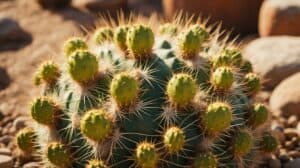Cyrtomium falcatum, commonly known as the Holly Fern, is a popular houseplant that belongs to the Dryopteridaceae family.
It is native to East Asia, particularly Japan, Korea, and China, and is prized for its attractive fronds, which resemble holly leaves.
The plant is easy to care for and can be grown in a variety of conditions, making it an ideal choice for beginners.

The Holly Fern is a perennial plant that can grow up to two feet tall and wide.
Its fronds are dark green and glossy, with a leathery texture and serrated edges that resemble the leaves of a holly bush.
The plant is slow-growing and can take several years to reach its full size, but it is well worth the wait for its striking appearance.
In this beginner’s guide to the Holly Fern, we will explore the various aspects of growing and caring for this beautiful plant.
From its ideal growing conditions to its propagation and maintenance, we will provide you with all the information you need to keep your Cyrtomium falcatum healthy and thriving.
Whether you are a seasoned houseplant enthusiast or a beginner looking for an easy-to-grow plant, the Holly Fern is sure to be a welcome addition to your collection.
Getting to Know Cyrtomium Falcatum
Species Overview
Cyrtomium Falcatum, commonly known as the Holly Fern, is a popular houseplant and garden fern that belongs to the Dryopteridaceae family.
It is native to eastern Asia, including China, Japan, Taiwan, and Korea.
The plant is known for its attractive, glossy green fronds that can grow up to 2 feet long and 6 inches wide.
The Holly Fern is an evergreen plant that can grow in both indoor and outdoor environments.
Its leaves are leathery and have a unique shape that resembles a holly leaf, hence its common name.
The plant is easy to care for and can thrive in a wide range of conditions, making it an excellent choice for beginner gardeners.
Origin and Habitat
The Holly Fern is native to the eastern regions of Asia, where it grows in shaded areas such as forests, rocky slopes, and stream banks.
The plant prefers a moist, well-draining soil and can tolerate a wide range of temperatures, from 20°F to 100°F.
In its natural habitat, the Holly Fern is often found growing alongside other ferns and shade-loving plants.
It is also known to be resistant to pests and diseases, making it a low-maintenance plant for gardeners.
Overall, the Holly Fern is a beautiful and versatile plant that is perfect for adding a touch of green to any indoor or outdoor space.
With its unique appearance and easy care requirements, it’s no wonder why it has become a popular choice for both novice and experienced gardeners alike.
Caring for Your Holly Fern

Lighting Requirements
Cyrtomium falcatum prefers bright, indirect light. Direct sunlight can be harmful to the plant and cause its leaves to burn.
It is best to place the plant near a window that receives bright, filtered light.
If you notice that the leaves are turning yellow or brown, it may be an indication that the plant is receiving too much light.
Watering Schedule
It is essential to keep the soil of your holly fern moist but not waterlogged.
Overwatering can cause root rot, while underwatering can cause the leaves to wilt and dry out. Water the plant when the top inch of soil feels dry to the touch.
The frequency of watering may vary depending on the temperature and humidity of your environment.
Soil Preferences
Holly ferns prefer well-draining soil that is rich in organic matter.
A mixture of peat moss, perlite, and sand can provide the ideal growing conditions for the plant.
Avoid using heavy soils that retain water, as they can cause the roots to rot.
Temperature and Humidity
Cyrtomium falcatum thrives in temperatures between 60-75°F (15-24°C) and high humidity levels.
If the air in your home is dry, you can increase the humidity around the plant by placing a tray of water near it or using a humidifier.
Avoid placing the plant in drafty areas or near heating or cooling vents.
By following these simple care guidelines, you can ensure that your holly fern remains healthy and vibrant.
With proper care, your plant can thrive and add a touch of natural beauty to your home.
Propagation and Repotting

Propagation Techniques
Cyrtomium falcatum can be propagated through spores or division. Spores are the tiny reproductive cells of ferns that can be collected from mature fronds.
To propagate through spores, one needs to collect mature fronds, place them in a paper bag, and let them dry for a few days.
Once the spores are released, they can be collected and sown in a mixture of peat moss and sand.
Keep the soil moist and place the container in a warm and bright location.
The spores will germinate in 2-3 weeks, and the young ferns can be transplanted to individual pots once they are big enough to handle.
Division is another way to propagate Cyrtomium falcatum. It involves separating the plant into smaller sections and replanting them in separate pots.
To divide the plant, remove it from its pot and gently separate the clumps of roots. Make sure each section has enough roots and foliage to survive on its own.
Replant each section in a new pot with fresh potting soil and water thoroughly.
When to Repot
Cyrtomium falcatum should be repotted every 2-3 years or when the roots start to outgrow the pot.
Signs that the plant needs to be repotted include roots growing out of the drainage holes, the soil drying out too quickly, or the plant becoming root-bound.
To repot, gently remove the plant from its pot and loosen the roots. Place the plant in a new pot with fresh potting soil and water thoroughly.
It is best to repot in the spring when the plant is actively growing.
When repotting, it is also a good idea to remove any dead or yellowing fronds and trim back any roots that are too long.
This will help the plant focus its energy on new growth and promote a healthy root system.
Common Issues and Solutions

Pest Problems
Cyrtomium falcatum is generally a hardy plant that is resistant to pests. However, it can sometimes be affected by spider mites, mealybugs and scale insects.
These pests can cause damage to the plant by feeding on its leaves, leading to stunted growth and yellowing of the leaves.
To prevent pest infestations, it is important to keep the plant clean and free of debris.
Regularly inspect the plant for signs of pests, and if you notice any, use an insecticidal soap or neem oil to eliminate them.
Disease Management
Cyrtomium falcatum is also susceptible to a few diseases, including root rot, leaf spot and powdery mildew.
These diseases can cause the leaves to turn brown or yellow and can eventually lead to the death of the plant.
To prevent these diseases, avoid overwatering the plant and ensure that it is planted in well-draining soil.
If you notice any signs of disease, remove the affected leaves and treat the plant with a fungicide.
Troubleshooting Yellowing Leaves
Yellowing leaves are a common issue with Cyrtomium falcatum, and can be caused by a variety of factors, including overwatering, underwatering, nutrient deficiencies, and pest infestations.
To troubleshoot yellowing leaves, first determine the cause of the issue.
If the plant is overwatered, reduce watering and ensure that the soil is well-draining.
If the plant is underwatered, increase watering and ensure that the soil is moist but not waterlogged.
If the issue is a nutrient deficiency, fertilize the plant with a balanced fertilizer.
If the issue is a pest infestation, treat the plant with an insecticidal soap or neem oil.
By following these simple tips, you can ensure that your Cyrtomium falcatum remains healthy and vibrant.
Frequently Asked Questions

What are the ideal indoor care tips for a holly fern?
Holly ferns are great indoor plants, but they require specific care to thrive.
To keep your holly fern healthy, place it in a bright spot where it can receive indirect sunlight. Keep the soil moist, but be careful not to overwater it.
It’s best to water your holly fern when the top inch of soil feels dry to the touch.
Avoid placing your holly fern near heating or cooling vents, as it prefers consistent temperatures.
How can I troubleshoot common problems with holly ferns?
If your holly fern’s fronds are turning yellow or brown, it may be a sign of overwatering or underwatering. Adjust your watering schedule accordingly.
If the fronds are wilting, it may be a sign of too much direct sunlight or not enough humidity.
Move your holly fern to a shadier spot or increase the humidity in the room.
What is the best hardiness zone for growing holly ferns?
Holly ferns are hardy in zones 6-10 and can tolerate a range of temperatures.
They prefer a slightly acidic soil with good drainage and can be grown in full to partial shade.
Which plants make the best companions for holly ferns in the garden?
Holly ferns make great companions for other shade-loving plants such as hostas, astilbes, and bleeding hearts.
They also pair well with ferns and other foliage plants.
What temperature range can holly ferns tolerate?
Holly ferns can tolerate temperatures as low as 20°F (-6°C) and as high as 85°F (29°C). However, they prefer temperatures between 60-70°F (15-21°C).
How often should I fertilize my holly fern and what type of fertilizer is best?
Holly ferns do not require frequent fertilization, but you can feed them once a month during the growing season with a balanced fertilizer.
Avoid overfertilizing, as this can cause the fronds to turn yellow.














